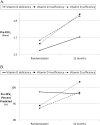Effect of vitamin D and inhaled corticosteroid treatment on lung function in children
- PMID: 22798322
- PMCID: PMC3480528
- DOI: 10.1164/rccm.201202-0351OC
Effect of vitamin D and inhaled corticosteroid treatment on lung function in children
Abstract
Rationale: Low vitamin D levels are associated with asthma and decreased airway responsiveness. Treatment with inhaled corticosteroids improves airway responsiveness and asthma control.
Objectives: To assess the effect of vitamin D levels on prebronchodilator FEV(1), bronchodilator response, and responsiveness to methacholine (PC(20), provocative concentration of methacholine producing a 20% decline in FEV(1)) in patients with asthma treated with inhaled corticosteroids.
Methods: We measured 25-hydroxyvitamin D levels in the serum of children with persistent asthma at the time of enrollment in the Childhood Asthma Management Program. We divided subjects into the vitamin D sufficiency (>30 ng/ml), insufficiency (20-30 ng/ml), and deficiency (<20 ng/ml) groups. Covariates included age, treatment, sex, body mass index, race, history of emergency department visits, hospitalizations, and season that vitamin D specimen was drawn. Our main outcome measures were change in prebronchodilator FEV(1), bronchodilator response, and PC(20) from enrollment to 8-12 months.
Measurements and main results: Of the 1,024 subjects, 663 (65%) were vitamin D sufficient, 260 (25%) were insufficient, and 101 (10%) were deficient. Vitamin D-deficient subjects were more likely to be older, African American, and have a higher body mass index compared with the vitamin D-sufficient and insufficient subjects. In the inhaled corticosteroid treatment group, prebronchodilator FEV(1) increased from randomization to 12 months by 140 ml in the vitamin D-deficient group and prebronchodilator FEV(1) increased by 330 ml in the vitamin D insufficiency group and by 290 ml in the vitamin D sufficiency group (P = 0.0072), in adjusted models.
Conclusions: In children with asthma treated with inhaled corticosteroids, vitamin D deficiency is associated with poorer lung function than in children with vitamin D insufficiency or sufficiency.
Figures

Comment in
-
Is the best offense a good D-fense? Should we use vitamin D as adjunctive therapy for asthma?Am J Respir Crit Care Med. 2012 Sep 15;186(6):470-2. doi: 10.1164/rccm.201207-1295ED. Am J Respir Crit Care Med. 2012. PMID: 22984020 No abstract available.
References
-
- Moorman JE, Rudd RA, Johnson CA, King M, Minor P, Bailey C, Scalia MR, Akinbami LJCenters for Disease Control and Prevention (CDC) National surveillance for asthma–United States, 1980–2004. MMWR Surveill Summ 2007;56:1–54 - PubMed
-
- Litonjua AA, Weiss ST. Is vitamin D deficiency to blame for the asthma epidemic? J Allergy Clin Immunol 2007;120:1031–1035 - PubMed
-
- Camargo CA, Jr, Ingham T, Wickens K, Thadhani R, Silvers KM, Epton MJ, Town GI, Pattemore PK, Espinola JA, Crane JNew Zealand Asthma and Allergy Cohort Study Group Cord-blood 25-hydroxyvitamin D levels and risk of respiratory infection, wheezing, and asthma. Pediatrics 2011;127:e180–e187 - PubMed
-
- Black PN, Scragg R. Relationship between serum 25-hydroxyvitamin D and pulmonary function in the third national health and nutrition examination survey. Chest 2005;128:3792–3798 - PubMed
Publication types
MeSH terms
Substances
Grants and funding
- N01-HR-16046/HR/NHLBI NIH HHS/United States
- N01-HR-16048/HR/NHLBI NIH HHS/United States
- U01HL075420/HL/NHLBI NIH HHS/United States
- N01-HR-16045/HR/NHLBI NIH HHS/United States
- N01-HR-16052/HR/NHLBI NIH HHS/United States
- K08 HL088046/HL/NHLBI NIH HHS/United States
- U01 HL075416/HL/NHLBI NIH HHS/United States
- M01 RR000051/RR/NCRR NIH HHS/United States
- K08HL088046/HL/NHLBI NIH HHS/United States
- U01 HL075415/HL/NHLBI NIH HHS/United States
- U01 HL075409/HL/NHLBI NIH HHS/United States
- U01HL075232/HL/NHLBI NIH HHS/United States
- U01HL075409/HL/NHLBI NIH HHS/United States
- N01-HR-16049/HR/NHLBI NIH HHS/United States
- RR00036/RR/NCRR NIH HHS/United States
- U01HL075407/HL/NHLBI NIH HHS/United States
- N01-HR-16051/HR/NHLBI NIH HHS/United States
- U01 HL075407/HL/NHLBI NIH HHS/United States
- M01 RR002719/RR/NCRR NIH HHS/United States
- U01 HL075420/HL/NHLBI NIH HHS/United States
- U01HL075416/HL/NHLBI NIH HHS/United States
- N01-HR-16044/HR/NHLBI NIH HHS/United States
- U01HL075415/HL/NHLBI NIH HHS/United States
- M01 RR000036/RR/NCRR NIH HHS/United States
- U01 HL065899/HL/NHLBI NIH HHS/United States
- N01 HR016044/HL/NHLBI NIH HHS/United States
- M01RR02719-14/RR/NCRR NIH HHS/United States
- U01 HL075417/HL/NHLBI NIH HHS/United States
- U01 HL075419/HL/NHLBI NIH HHS/United States
- U01HL075419/HL/NHLBI NIH HHS/United States
- U01 HL075408/HL/NHLBI NIH HHS/United States
- U01HL065899/HL/NHLBI NIH HHS/United States
- U01 HL075232/HL/NHLBI NIH HHS/United States
- R21 HL089842/HL/NHLBI NIH HHS/United States
- N01-HR-16050/HR/NHLBI NIH HHS/United States
- U01HL075408/HL/NHLBI NIH HHS/United States
- N01-HR-16047/HR/NHLBI NIH HHS/United States
- U01HL075417/HL/NHLBI NIH HHS/United States
- M01RR00051/RR/NCRR NIH HHS/United States
- M01RR0099718-24/RR/NCRR NIH HHS/United States
LinkOut - more resources
Full Text Sources
Other Literature Sources
Medical

